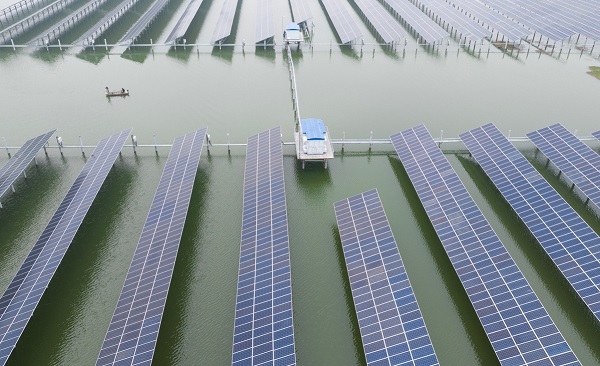Green power certificates set record

An elevated view of the floating photovoltaic power generation project in Shiguan town, Lai'an county, Anhui province. [Photo provided to chinadaily.com.cn]
Some 24.82 million green power certificates, corresponding to 24.8 billion kilowatt-hours of electricity generated from renewable sources, have been traded in the last week of June on the Guangzhou Power Exchange Center in Guangdong province, marking China's largest single-batch green power certificate transactions as of date, China Southern Power Grid told China Daily on Thursday.
The transactions, organized by the GPEC, a subsidiary of CSG, involved 654 entities, including Guangdong Energy Group and Shenzhen Energy Group.
This also marked the first time that companies in Guangdong province traded large-scale cross-regional green power certificates with new energy enterprises in western regions such as Gansu province, Ningxia Hui autonomous region and Xinjiang Uygur autonomous region.
The transactions helped reduce carbon dioxide emissions by about 19.84 million metric tons, according to China Southern Power Grid.
Green power certificates act as electronic IDs for green power transactions. Due to the homogeneity of electricity, once it enters the grid for transmission, its attributes cannot be distinguished by the grid or consumers. Only the generation side can differentiate it using green certificates.
Green power certificates are now assessed and issued by the National Energy Administration. Each certificate represents 1,000 kWh of green power generated from renewable sources.
Experts believe that the issuance of green certificates, assigning additional economic value to renewable energies will help new energy generation companies generate additional revenue by selling the certificates and granting users proof of carbon footprint reductions.
"With an increasing number of economies incorporating carbon footprint assessments into foreign trade transactions, green certificates provide traceable proof for Chinese electricity users on the consumption of green power," said Lin Boqiang, head of the China Institute for Studies in Energy Policy at Xiamen University.
The NEA is actively promoting comprehensive coverage of green power certificates for renewable energy development. Recently, the national green power certificate issuance and trading system started operations, encouraging participants to establish real-name accounts containing information on the certificates they hold and trade.
Relevant trading data are transmitted in real time by a national renewable energy information management center that is operated by the China Renewable Energy Engineering Institute, as well as the power exchange centers in Beijing, Guangzhou and the Inner Mongolia autonomous region. Renewable energy generation enterprises or project owners can also fill in the necessary information on their own.
Lin said that currently, regions and countries such as Europe and the United States have developed traceable proof on green power used across various industries. Relevant departments in China are also actively promoting the mutual recognition of green power certificates with those developed in other economies.
Copyright © Foreign Affairs Office of Guangzhou Municipal Government,
Hong Kong and Macao Affairs Office of Guangzhou Municipal Government All rights reserved.
Presented by China Daily.
京ICP备13028878号-28



